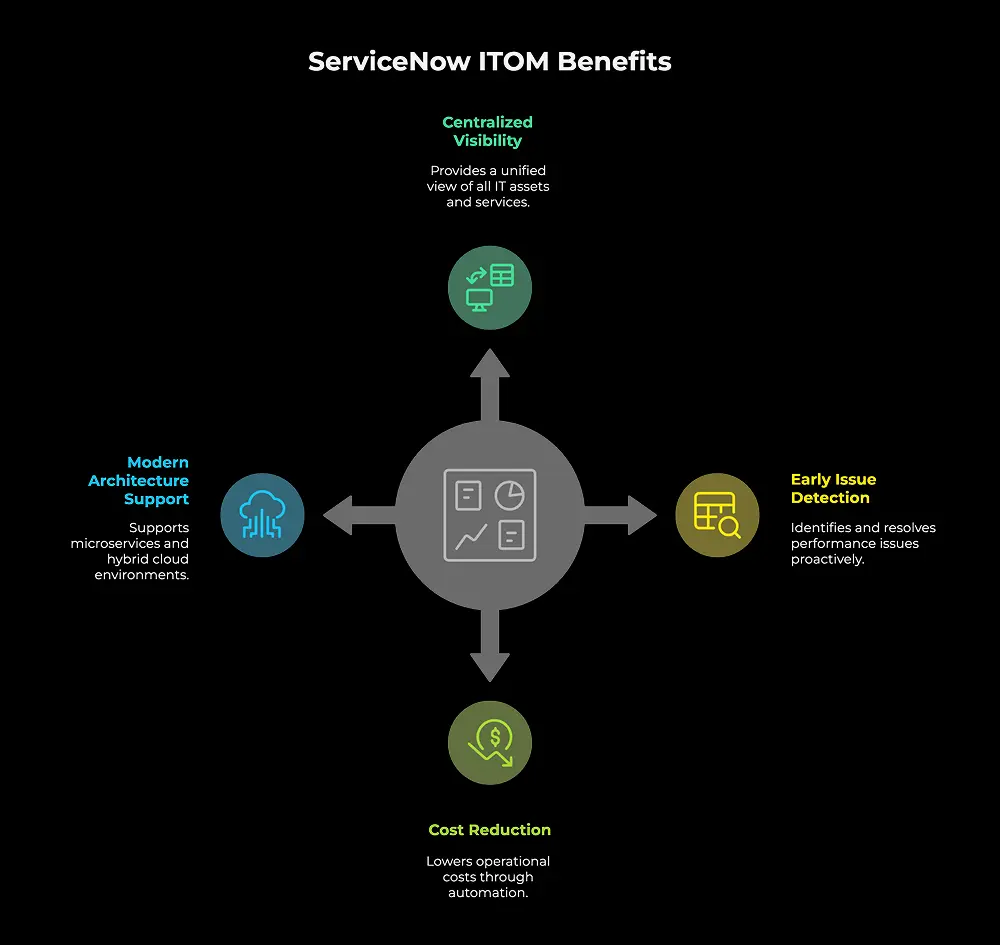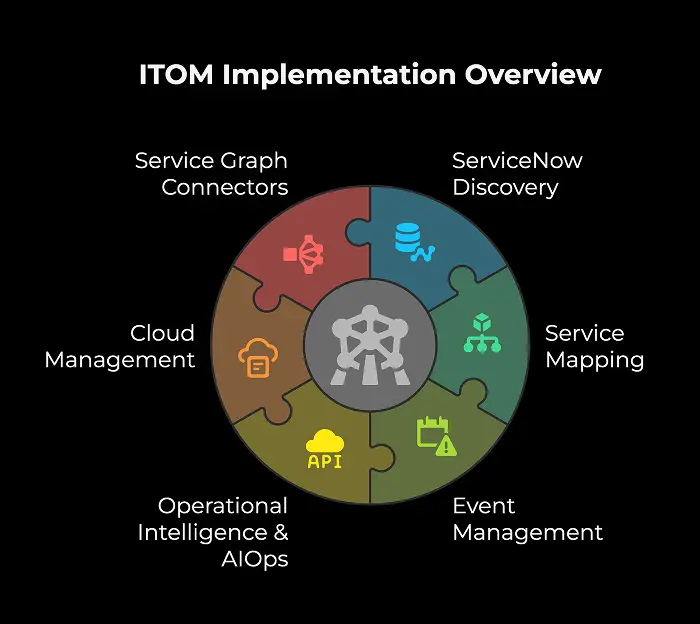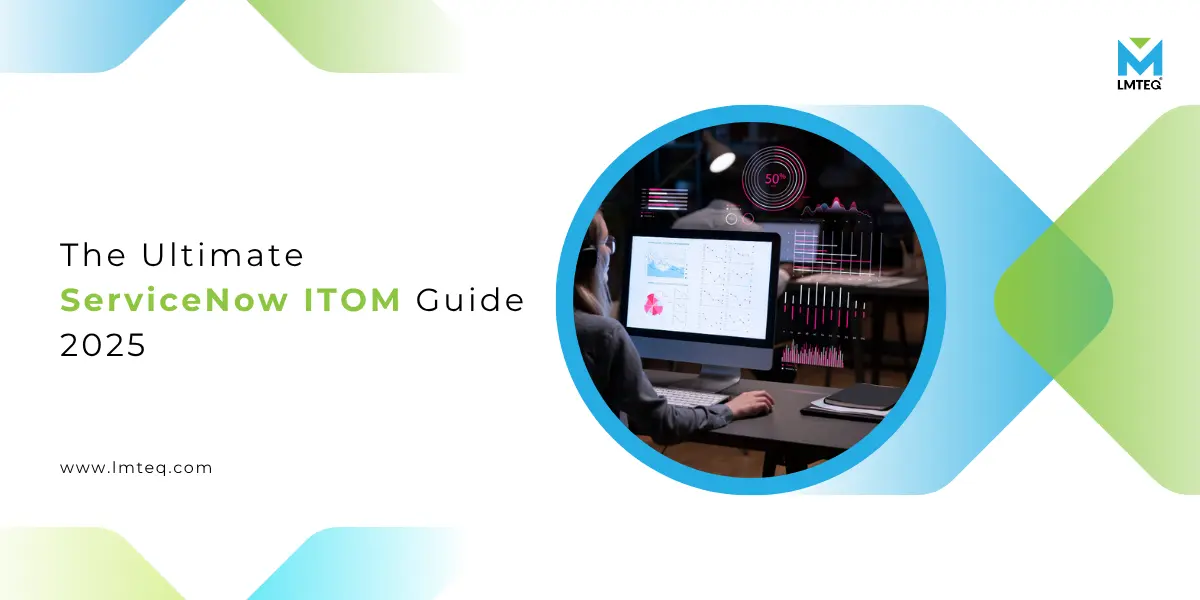Managing modern IT operations is no small feat. With increasingly complex infrastructures, hybrid cloud environments, and mounting pressure on uptime and visibility, businesses are turning to ServiceNow ITOM to stay in control.
From digital banking to connected factories, businesses need constant uptime, visibility, and automation. That’s where ServiceNow ITOM (IT Operations Management) steps in.
According to a recent IDC study, companies using ServiceNow ITOM reported:
- 55% fewer service outages
- 60% faster root-cause identification
- 45% improved infrastructure visibility
This guide is built for beginners and intermediate users who want to understand what ServiceNow ITOM does, how it works, and how it helps in real-world industry settings like BFSI, Manufacturing, and TMT. We’ll also explore the role of AI, automation, and workflow data fabric in reshaping IT operations.
What is ServiceNow ITOM?

ServiceNow ITOM is a set of applications designed to help organizations manage and optimize their IT infrastructure. It provides visibility, health monitoring, root-cause analysis, and automation across both on-premises and cloud environments.
Unlike ITSM (which handles tickets and workflows), ITOM focuses on the underlying infrastructure, the servers, databases, cloud services, and network devices that keep services running.
Key benefits of ServiceNow ITOM include:
- Centralized visibility of all IT assets and services
- Early detection and resolution of performance issues
- Reduction in operational costs through automation
- Support for modern architectures like microservices and hybrid cloud
Core Components of ITOM Implementation with ServiceNow

1. ServiceNow Discovery
ServiceNow Discovery automatically scans your network to identify devices, software, cloud resources, and their relationships. It updates the CMDB (Configuration Management Database) in real-time.
Simple example :- Think of Discovery as airport security, scanning every bag (or server) and adding it to a logbook (the CMDB).
Why it matters :-
- Eliminates manual asset tracking
- Prevents configuration drift
- Enables accurate service impact analysis
“A BFSI firm saved over $400,000 annually by identifying and decommissioning underutilized servers using Discovery.”
Download Now :-
ServiceNow CMDB Readiness Check | Resource
2. Service Mapping
While Discovery tells you what assets exist, Service Mapping shows you how they work together. It visually connects applications, databases, and infrastructure components into end-to-end service maps.
Why it matters :–
- Enhances change impact analysis
- Reduces downtime by pinpointing root causes
- Helps understand dependencies during cloud migrations
“A manufacturing firm used service mapping to visualize production apps and cut troubleshooting time by 70%.”
3. Event Management
ServiceNow Event Management ingests alerts from multiple monitoring tools like Datadog, SolarWinds, New Relic, and AppDynamics. It uses machine learning to filter noise and highlight actionable issues.
Benefits :-
- Reduces alert fatigue
- Speeds up incident resolution
- Supports proactive monitoring
A telecom giant reduced false alerts by 50% after centralizing monitoring with Event Management.
4. Operational Intelligence & AIOps
Operational Intelligence uses machine learning to detect anomalies and trends. When combined with AIOps (Artificial Intelligence for IT Operations), it can even predict outages and automatically recommend fixes.
Use case :- A ServiceNow AI agent spots unusual memory spikes and alerts the team before a server crash.
“On average, companies using AIOps in ITOM reduce MTTR (mean time to resolve) by 45%.”
5. Cloud Management
This module offers visibility and governance across multi-cloud environments like AWS, Azure, and GCP.
Features :-
- Automated provisioning
- Usage and cost optimization
- Policy-driven resource control
Why it matters :- Cloud sprawl is expensive. ITOM ensures your cloud usage stays lean and cost-effective.
6. Service Graph Connectors
Service Graph Connectors feed trusted external data into the CMDB — such as SCCM, VMware vCenter, or AWS Config — keeping it enriched and relevant.
“A logistics firm improved CMDB accuracy by 60% in just 3 months using Service Graph Connectors.”
MID Server in ServiceNow ITOM
The MID Server (Management, Instrumentation, and Discovery) is the hidden engine behind Discovery and integrations. It’s a lightweight Java application installed behind your firewall that performs secure communication between your ServiceNow instance and internal systems
Functions :-
- Executes discovery probes
- Facilitates integrations with databases, AD, SIEM, etc.
- Triggers orchestration tasks securely
Without MID Server, integrating your local AD or legacy infrastructure into ServiceNow would pose security risks.
Real-world impact :- A healthcare provider used MID Server to integrate on-prem systems with ServiceNow ITOM without violating HIPAA guidelines.
SIEM Integration in ServiceNow
SIEM Integration in ServiceNow helps merge your security insights into IT operations. It integrates with Splunk, IBM QRadar, Sentinel, and others.
Use Cases :-
- Alert correlation between ops and security
- Automated incident logging and escalation
- Faster compliance audits
A BFSI enterprise integrated Splunk with ITOM and reduced threat detection-to-resolution time by 40%.
Automation in ITOM
Manual operations are error-prone and slow. ServiceNow ITOM supports automation through Orchestration, Flow Designer, and Playbooks.
What can you automate?
- Restarting failed servers
- Auto-ticket creation for recurring alerts
- Cloud resource provisioning
- AD user cleanup workflows
- CPU threshold monitoring
- SIEM monitoring
A global enterprise automated 80% of server patching, cutting downtime by 75% and saving thousands of work hours.
Real-World ITOM Use Cases in BFSI and Manufacturing
BFSI
Pain Points :-
- Complex legacy systems
- High uptime requirements
- Regulatory compliance
Use Case :-A private bank implemented ServiceNow Discovery and Service Mapping across their data center. Coupled with Event Management and SIEM integration, they achieved:
- 70% improvement in system availability
- 60% reduction in incident volume
- Full visibility into 1,500+ assets
Manufacturing
Pain Points :-
- IT/OT integration
- Real-time incident visibility
- Asset sprawl across sites
Use Case :-A global manufacturer connected factory systems to ServiceNow using MID Server and Service Graph Connectors, creating a unified operational dashboard.
Results :-
- 30% faster repair times
- Reduced plant downtime by 25%
- Higher accuracy in inventory asset tracking
ITOM for TMT (Technology, Media, Telecom)
Pain Points :-
- Thousands of alerts from multiple tools
- Fast-paced change cycles
- Distributed cloud-native architectures
Use Case :- A telecom provider integrated Datadog and SolarWinds into ServiceNow Event Management. With AIOps and agentic AI, they clustered alerts into incidents and reduced MTTR by 60%.
Agentic AI for IT Operations
This is the future of ITOM — and it’s already here.
Agentic AI refers to intelligent, autonomous agents in ServiceNow that act independently to monitor, assess, and resolve operational issues. It’s a step beyond AIOps.
Capabilities :-
- Learning from historical trends
- Taking preemptive actions (e.g., reassigning load, restarting services)
- Automatically generating change requests and running remediation
Example :- An AI agent detects storage pressure, predicts a failure, shifts non-critical loads, and creates a change request, all autonomously.
Workflow Data Fabric in ITOM
Think of Workflow Data Fabric as the nervous system of ServiceNow. It connects modules, processes, and data sources, enabling seamless flow and correlation.
Benefits :-
- Unified data layer across ITOM, ITSM, SecOps, and DevOps
- Reduces data silos and duplication
- Powers real-time analytics and dashboards
Without Workflow Data Fabric, automation and AI insights are fragmented and less effective.
Measurable Business Benefits
| Metric | Improvement |
|---|---|
| Visibility into infrastructure | +70% |
| Mean time to repair (MTTR) | -60% |
| Incident volume | -45% |
| Change success rate | +40% |
| Operational overhead | -35% |
| Compliance tracking speed | -+50% |
Also Reads :-
Final Thoughts
If you’re operating in banking, manufacturing, telecom, or any large-scale IT environment, you need real-time visibility, faster resolutions, and streamlined operations. That’s exactly what ServiceNow ITOM for ITOps delivers.
With a strong CMDB, robust discovery, AI-powered alerting, and cross-platform automation, ServiceNow ITOM acts as your centralized control hub. Add agentic AI and workflow data fabric, and you have an operations layer that can scale, adapt, and self-heal.
The future of IT Operations isn’t just automated. It’s intelligent.
At LMTEQ, our team has industry hands-on experience and a proven track record of understanding business requirements and tailoring the ServiceNow solution and implementing it at a record-breaking pace.
If you are looking for ServiceNow ITOM implementation or support, contact us today.
FAQs
1. What is the difference between ITOM and ITSM in ServiceNow?
ITSM manages requests, incidents, and workflows. ServiceNow ITOM focuses on infrastructure, automation, monitoring, and service visibility. ITOM supports and enhances ITSM outcomes.
2. What role does the MID Server play in ServiceNow ITOM?
The MID Server in ServiceNow ITOM facilitates secure communication between your on-prem environment and the ServiceNow cloud. It supports Discovery, integrations, and automation.
3. Can ServiceNow ITOM handle security data?
Yes. SIEM Integration in ServiceNow allows security data to flow into ITOM workflows for alert correlation, automated playbooks, and compliance reporting.
